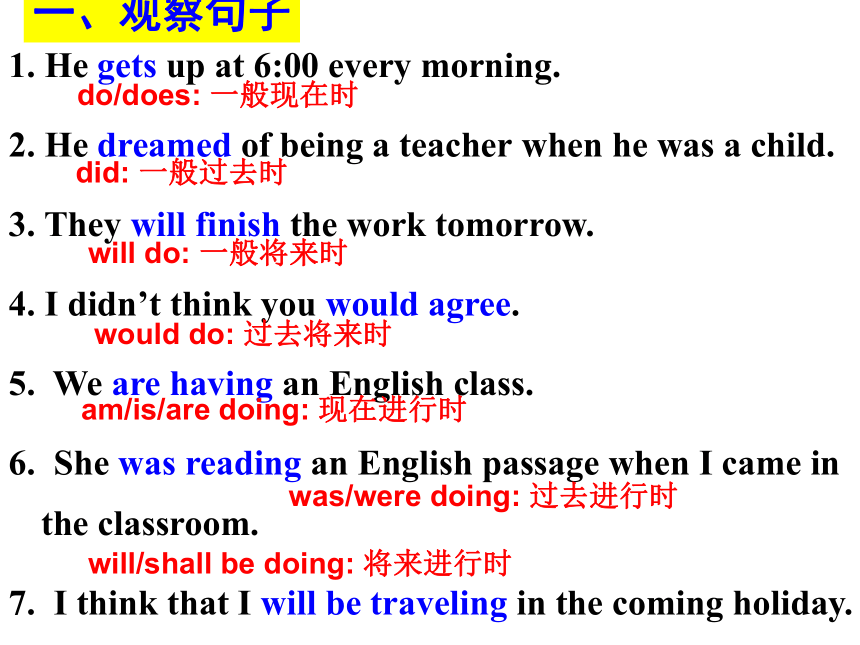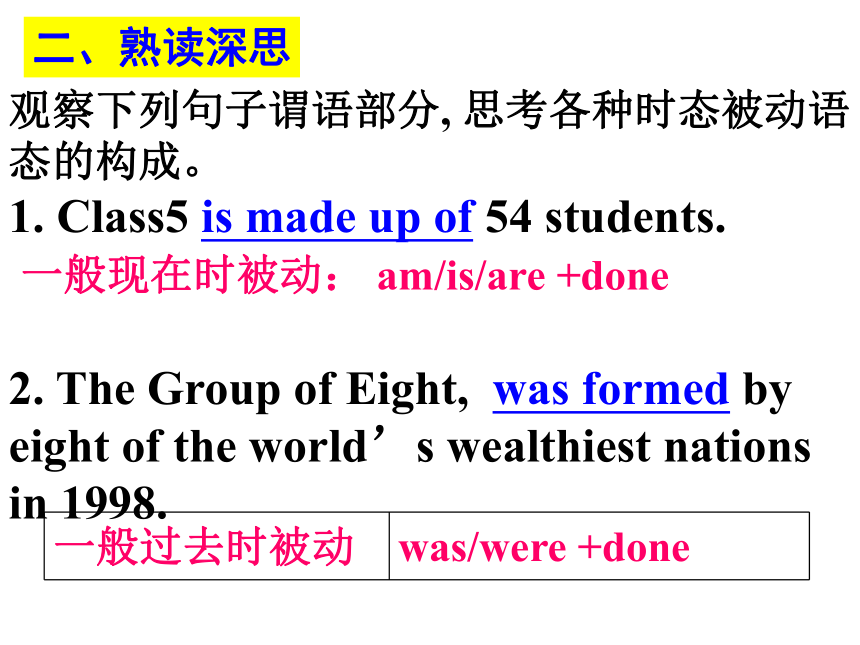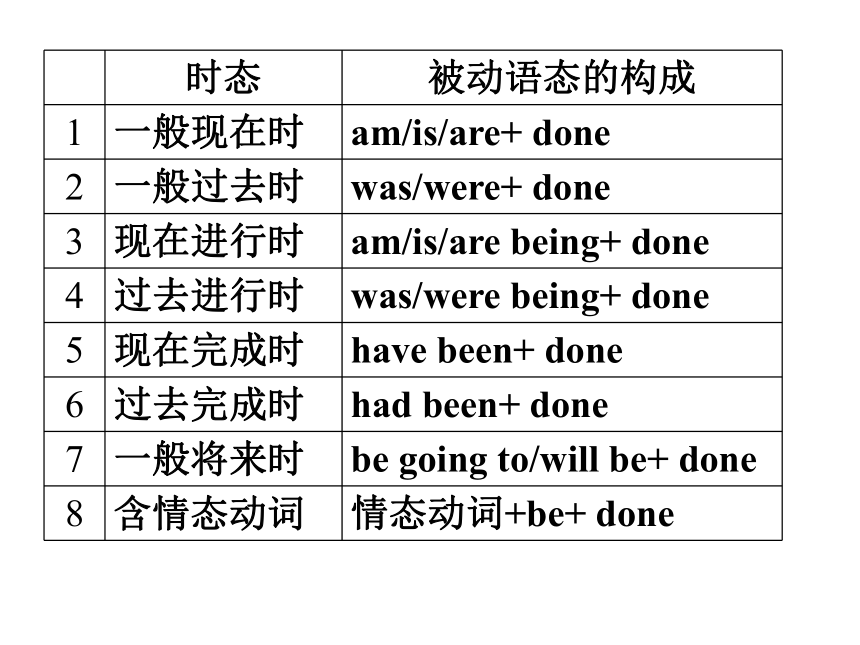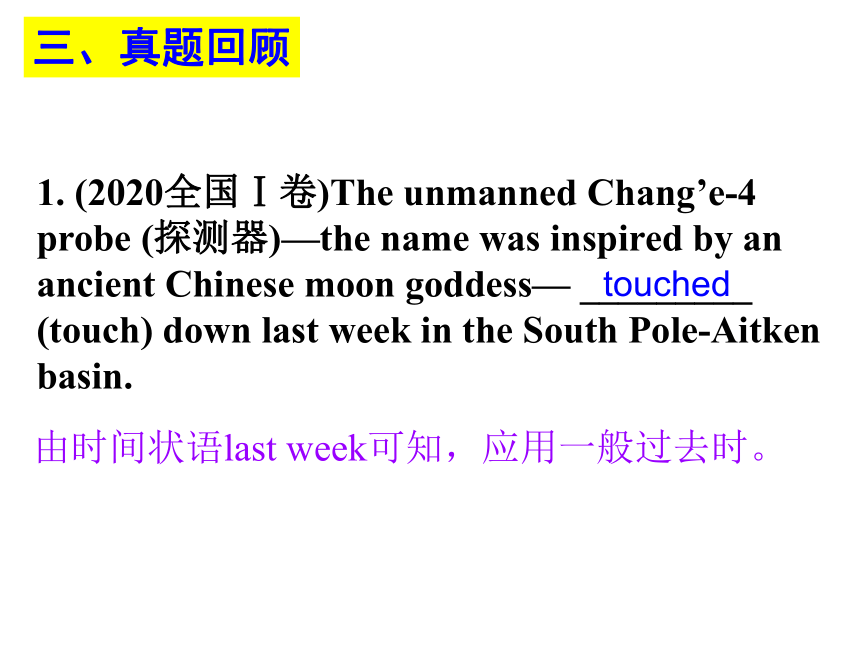2022届高三英语二轮复习时态语态课件(24张PPT)
文档属性
| 名称 | 2022届高三英语二轮复习时态语态课件(24张PPT) |  | |
| 格式 | zip | ||
| 文件大小 | 178.1KB | ||
| 资源类型 | 教案 | ||
| 版本资源 | 人教版(2019) | ||
| 科目 | 英语 | ||
| 更新时间 | 2022-01-20 12:33:47 | ||
图片预览









文档简介
(共24张PPT)
时态语态
1. He gets up at 6:00 every morning.
2. He dreamed of being a teacher when he was a child.
3. They will finish the work tomorrow.
4. I didn’t think you would agree.
5. We are having an English class.
6. She was reading an English passage when I came in the classroom.
7. I think that I will be traveling in the coming holiday.
do/does: 一般现在时
did: 一般过去时
will do: 一般将来时
would do: 过去将来时
am/is/are doing: 现在进行时
was/were doing: 过去进行时
will/shall be doing: 将来进行时
一、观察句子
have/has done: 现在完成时
8. She has been in the army since she was 20 years old.
9. When I reached the station, the star had left.
10. I have been teaching English for 10 years.
had done: 过去完成时, 即“过去的过去”;
have/has been doing: 现在完成进行时
观察下列句子谓语部分, 思考各种时态被动语态的构成。
1. Class5 is made up of 54 students.
一般现在时被动: am/is/are +done
2. The Group of Eight, was formed by eight of the world’s wealthiest nations in 1998.
一般过去时被动 was/were +done
二、熟读深思
3. The news is being celebrated by people in the streets.
现在进行时被动:am/is/are being +done
4. At 12:45 UK time today, the name of the host city for the 2012 Olympic Games was being announced by IOC in Singapore.
过去进行时被动 was/were being +done
5. The book has been read by us.
现在完成时被动:have been +done
6. London’s name had been announced twice before.
过去完成时被动 had been +done
7. It is going to be remembered as a historical meeting this year, as the topic of Africa will be discussed in detail
一般将来时被动:be going to/will be+ done
8. They want the leaders to cancel the debt of Africa’s poorest countries so that the problems there can be prevented from getting worse.
含情态动词被动 情态动词+be +done
时态 被动语态的构成
1 一般现在时 am/is/are+ done
2 一般过去时 was/were+ done
3 现在进行时 am/is/are being+ done
4 过去进行时 was/were being+ done
5 现在完成时 have been+ done
6 过去完成时 had been+ done
7 一般将来时 be going to/will be+ done
8 含情态动词 情态动词+be+ done
1. (2020全国Ⅰ卷)The unmanned Chang’e-4 probe (探测器)—the name was inspired by an ancient Chinese moon goddess— _________ (touch) down last week in the South Pole-Aitken basin.
由时间状语last week可知,应用一般过去时。
touched
三、真题回顾
2. (2020全国Ⅰ卷) “This really excites scientists,” Carle Pieters, a scientist at Brown University,
says, “because it ________ (mean) we have the chance to obtain information about how the moon ______________ (construct).”
结合语境和上文的This really excites scientist可知,此处陈述客观事实,应用一般现在时;且主语为it,为第三人称单数,故填means;
此处陈述客观事实,应用一般现在时,从句主语the moon和construct之间为被动关系,应用被动语态,且the moon为单数,谓语应用第三人称单数形式,故填is constructed。
means
is constructed
3. (2020全国Ⅱ卷) This is why decorating
with plants, fruits and flowers __________
(carry) special significance.
此处陈述客观事实,应用一般现在时;
从句的主语为动名词短语decorating with plants, fruits and flowers,谓语应用第三人称单数形式,故填carries。
carries
4. (2020全国Ⅲ卷) When he asked the villagers on the banks of the river where he could find the legendary (传奇的) artist, they smiled and _______ (point) down the river.
5. (2020新高考全国Ⅰ卷) The 80,000 objects collected by Sir Hans Sloane, for example, _______ (form) the core collection of the British Museum which opened in 1759.
根据上下文谓语动词的时态可知,应用一般过去时。
pointed
formed
根据上文谓语动词的时态,且设空处与and前的
smiled并列,可知用一般过去时。
6. (2020新高考全国Ⅰ卷) The parts of a museum open to the public __________ (call) galleries or rooms.
主语parts为可数名词复数, 与call之间为被动关系, 应用被动语态; 且此处陈述客观事实, 应用一般现在时。故填are called。
are called
7. (2020新高考全国Ⅰ卷) Often, only a small part of a museum’s collection ___ (be) on display.
此处陈述客观事实,用一般现在时; “a part of+名词” 作主语时,谓语动词的数取决于of后的名词是单数还是复数,由collection为单数可知,谓语动词应用单数形式,故填is。
is
8. (2020新高考全国Ⅱ卷) Because the number
of possible topics ____ (be) practically limitless, we focus on a sample of the most interesting
and useful applications and tools and explain the basic principles of technology.
the number of (……的数目)后接可数名词
复数,谓语动词用单数。根据下文谓语动词
的时态可知,用一般现在时,故填is。
is
9. (2020新高考全国Ⅱ卷) … we focus on a sample
of the most interesting and useful applications and tools and explain the basic principles of technology. Readers ________________ (encourage) to continue exploring the digital world with the guidance of our Further Resources section featured in each volume.
主语Readers与encourage之间为被动关系,应用被动语态。根据上文谓语动词的时态可知,用一般现在时,故填are encouraged。
are encouraged
10. (2019全国Ⅰ卷) In recent years some Inuit people in Nunavut _______________ (report) increases in bear sightings around human settlements...
have reported
由时间状语in recent years可知,此处用现在完成时态,故填have reported。
11. (2019全国Ⅱ卷)Iran said, “I don’t see amy reason to give up work. I love coming here and seeing my family and all the friends I __________ (make) over the years.”
have made
由时间状语“over the years”可知,此处应用现在完成时态,故填have made。
考情:谓语在高考中不但每年必考
而且是考查的重点,考1~2题。主要考
查:(1)动词时态,主要是上下文时态一致和并列一致;(2)被动语态;(3)主谓一致。
四、考情分析
解法:
1. 要弄清全文是叙述过去发生了的事还是客观地讲述目前的情况,特别留意上下文的时态,因为上下文时态一致是考查的重点,并列一致一定要弄清跟谁并列。
2. 要分析主语与谓语动词之间是主动关系还是被动关系。被动语态一定是“助动词be+过去分词”;主动语态,若是行为动词且不是进行时,不能用be。
3. 主谓一致主要是找准主语。
1. Last month, the Japanese government expressed their thanks for the aid they ___________ (receive) from China.
从时间上看, 应该是先得到援助, 然后才表示感谢, 由于“表达”用的是一般过去时(expressed), 所以“得到援助”就应用过去完成时(had received)。
had received
四、More exercises
2. By the time Jack returned home from England, his son _____________(graduate) from college.
3. Tom ________________(work) in the library every night over the last three months.
4. — Tommy is planning to buy a car.
— I know. By next month, he _____ _____(save)enough for a used one.
had graduated
has been working
will have saved
5. Every few years, the coal workers _____(have) their lungs X-rayed to ensure their health.
6.The book has been translated into thirty languages since it _____ (come) on the market in 1973.
7.When you are home, give a call to let me know you _____________(arrive) safely.
came
have arrived
have
Thank You !
时态语态
1. He gets up at 6:00 every morning.
2. He dreamed of being a teacher when he was a child.
3. They will finish the work tomorrow.
4. I didn’t think you would agree.
5. We are having an English class.
6. She was reading an English passage when I came in the classroom.
7. I think that I will be traveling in the coming holiday.
do/does: 一般现在时
did: 一般过去时
will do: 一般将来时
would do: 过去将来时
am/is/are doing: 现在进行时
was/were doing: 过去进行时
will/shall be doing: 将来进行时
一、观察句子
have/has done: 现在完成时
8. She has been in the army since she was 20 years old.
9. When I reached the station, the star had left.
10. I have been teaching English for 10 years.
had done: 过去完成时, 即“过去的过去”;
have/has been doing: 现在完成进行时
观察下列句子谓语部分, 思考各种时态被动语态的构成。
1. Class5 is made up of 54 students.
一般现在时被动: am/is/are +done
2. The Group of Eight, was formed by eight of the world’s wealthiest nations in 1998.
一般过去时被动 was/were +done
二、熟读深思
3. The news is being celebrated by people in the streets.
现在进行时被动:am/is/are being +done
4. At 12:45 UK time today, the name of the host city for the 2012 Olympic Games was being announced by IOC in Singapore.
过去进行时被动 was/were being +done
5. The book has been read by us.
现在完成时被动:have been +done
6. London’s name had been announced twice before.
过去完成时被动 had been +done
7. It is going to be remembered as a historical meeting this year, as the topic of Africa will be discussed in detail
一般将来时被动:be going to/will be+ done
8. They want the leaders to cancel the debt of Africa’s poorest countries so that the problems there can be prevented from getting worse.
含情态动词被动 情态动词+be +done
时态 被动语态的构成
1 一般现在时 am/is/are+ done
2 一般过去时 was/were+ done
3 现在进行时 am/is/are being+ done
4 过去进行时 was/were being+ done
5 现在完成时 have been+ done
6 过去完成时 had been+ done
7 一般将来时 be going to/will be+ done
8 含情态动词 情态动词+be+ done
1. (2020全国Ⅰ卷)The unmanned Chang’e-4 probe (探测器)—the name was inspired by an ancient Chinese moon goddess— _________ (touch) down last week in the South Pole-Aitken basin.
由时间状语last week可知,应用一般过去时。
touched
三、真题回顾
2. (2020全国Ⅰ卷) “This really excites scientists,” Carle Pieters, a scientist at Brown University,
says, “because it ________ (mean) we have the chance to obtain information about how the moon ______________ (construct).”
结合语境和上文的This really excites scientist可知,此处陈述客观事实,应用一般现在时;且主语为it,为第三人称单数,故填means;
此处陈述客观事实,应用一般现在时,从句主语the moon和construct之间为被动关系,应用被动语态,且the moon为单数,谓语应用第三人称单数形式,故填is constructed。
means
is constructed
3. (2020全国Ⅱ卷) This is why decorating
with plants, fruits and flowers __________
(carry) special significance.
此处陈述客观事实,应用一般现在时;
从句的主语为动名词短语decorating with plants, fruits and flowers,谓语应用第三人称单数形式,故填carries。
carries
4. (2020全国Ⅲ卷) When he asked the villagers on the banks of the river where he could find the legendary (传奇的) artist, they smiled and _______ (point) down the river.
5. (2020新高考全国Ⅰ卷) The 80,000 objects collected by Sir Hans Sloane, for example, _______ (form) the core collection of the British Museum which opened in 1759.
根据上下文谓语动词的时态可知,应用一般过去时。
pointed
formed
根据上文谓语动词的时态,且设空处与and前的
smiled并列,可知用一般过去时。
6. (2020新高考全国Ⅰ卷) The parts of a museum open to the public __________ (call) galleries or rooms.
主语parts为可数名词复数, 与call之间为被动关系, 应用被动语态; 且此处陈述客观事实, 应用一般现在时。故填are called。
are called
7. (2020新高考全国Ⅰ卷) Often, only a small part of a museum’s collection ___ (be) on display.
此处陈述客观事实,用一般现在时; “a part of+名词” 作主语时,谓语动词的数取决于of后的名词是单数还是复数,由collection为单数可知,谓语动词应用单数形式,故填is。
is
8. (2020新高考全国Ⅱ卷) Because the number
of possible topics ____ (be) practically limitless, we focus on a sample of the most interesting
and useful applications and tools and explain the basic principles of technology.
the number of (……的数目)后接可数名词
复数,谓语动词用单数。根据下文谓语动词
的时态可知,用一般现在时,故填is。
is
9. (2020新高考全国Ⅱ卷) … we focus on a sample
of the most interesting and useful applications and tools and explain the basic principles of technology. Readers ________________ (encourage) to continue exploring the digital world with the guidance of our Further Resources section featured in each volume.
主语Readers与encourage之间为被动关系,应用被动语态。根据上文谓语动词的时态可知,用一般现在时,故填are encouraged。
are encouraged
10. (2019全国Ⅰ卷) In recent years some Inuit people in Nunavut _______________ (report) increases in bear sightings around human settlements...
have reported
由时间状语in recent years可知,此处用现在完成时态,故填have reported。
11. (2019全国Ⅱ卷)Iran said, “I don’t see amy reason to give up work. I love coming here and seeing my family and all the friends I __________ (make) over the years.”
have made
由时间状语“over the years”可知,此处应用现在完成时态,故填have made。
考情:谓语在高考中不但每年必考
而且是考查的重点,考1~2题。主要考
查:(1)动词时态,主要是上下文时态一致和并列一致;(2)被动语态;(3)主谓一致。
四、考情分析
解法:
1. 要弄清全文是叙述过去发生了的事还是客观地讲述目前的情况,特别留意上下文的时态,因为上下文时态一致是考查的重点,并列一致一定要弄清跟谁并列。
2. 要分析主语与谓语动词之间是主动关系还是被动关系。被动语态一定是“助动词be+过去分词”;主动语态,若是行为动词且不是进行时,不能用be。
3. 主谓一致主要是找准主语。
1. Last month, the Japanese government expressed their thanks for the aid they ___________ (receive) from China.
从时间上看, 应该是先得到援助, 然后才表示感谢, 由于“表达”用的是一般过去时(expressed), 所以“得到援助”就应用过去完成时(had received)。
had received
四、More exercises
2. By the time Jack returned home from England, his son _____________(graduate) from college.
3. Tom ________________(work) in the library every night over the last three months.
4. — Tommy is planning to buy a car.
— I know. By next month, he _____ _____(save)enough for a used one.
had graduated
has been working
will have saved
5. Every few years, the coal workers _____(have) their lungs X-rayed to ensure their health.
6.The book has been translated into thirty languages since it _____ (come) on the market in 1973.
7.When you are home, give a call to let me know you _____________(arrive) safely.
came
have arrived
have
Thank You !
